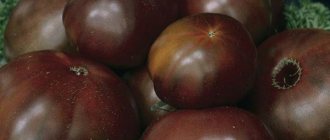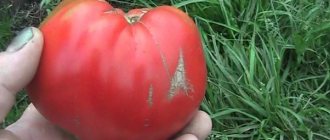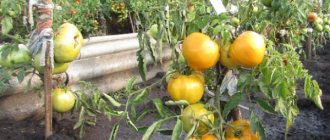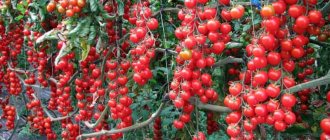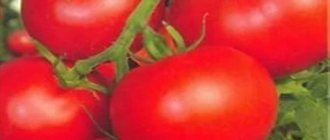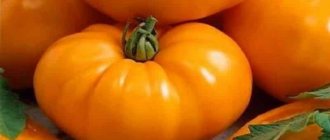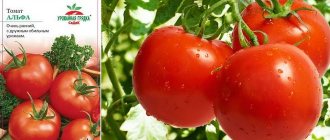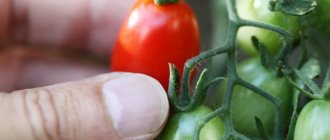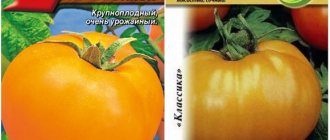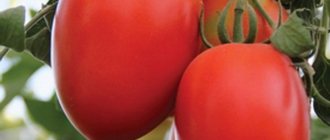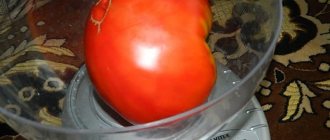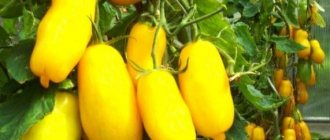Loading…
Loading…
A new type of mid-season tomato with bright colors, the Pepper tomato, is distinguished by its unusual fruit shape. Outwardly, it cannot be distinguished from sweet pepper. Various varieties are distinguished by good yield and taste.
Pepper tomato is grown in a greenhouse and in open ground. In regions with a warm, mild climate, the crop bears fruit until mid-October.
During the season, one bush produces about 30 kg of fruit. They are sweetish in taste, fleshy, covered with a thick skin. There are few seeds inside the fruit. This feature appeals to cooks and upsets vegetable growers, who have to work hard to collect seeds for planting next year.
The process of growing tomatoes depends on their characteristics. There are low-growing and tall-growing pepper tomatoes. Some require pinching and gartering, while others require no support at all.
Indeterminate and determinate species are distinguished by the shape of the berry and its color:
- black;
- red;
- orange;
- yellow;
- pink.
Let's take a closer look at the best varieties of pepper tomatoes and the features of their cultivation.
Variety Krepysh
An early variety that is well suited for growing in the harsh climate of Western Siberia. Created by Siberian scientists for cultivation in open ground. Well adapted to cold weather.
Features of the variety
Tomato Pepper-shaped Strong has the following advantages:
- begins to bear fruit early, approximately 105 days after planting;
- not susceptible to many diseases;
- has a compact round shape;
- does not need a garter (bush height no more than 35 cm);
- Large raspberry-colored fruits are suitable for canning and fresh consumption.
Agricultural technology
Seeds are planted in a nutrient substrate at least 50 days before transplanting to the garden bed. To obtain seedlings, it is necessary to ensure a temperature regime within the range of 22 - 25 ° C. Before planting in the ground, the young plants must be hardened off. For 1 sq. m. no more than 3 – 4 plants are placed. During the season, seedlings are fertilized with mineral fertilizers. Abundant watering is combined with loosening the dried top layer of soil for good aeration of the roots.
Nuances for open and protected ground
The variety is recommended for cultivation in open ground in the southern regions and in greenhouse conditions in the northern regions . In the middle zone, it is necessary to have covering material on hand in case of a sharp drop in temperature or prolonged rains.
When the temperature drops unexpectedly, the tomato is fed with calcium ions . This is especially necessary when setting fruit, since in cold air they are affected by fungal diseases, for example, blossom end rot. Feeding with calcium protects the ovaries from fungus.
Stop watering 2 weeks before the vegetables ripen , as the increased amount of moisture may cause the fruits to crack.
In August, the tops of plants are pinched . This not only prevents further growth, but also prevents new inflorescences from forming.
Variety Striped
Striped Pepper Dwarf is a tomato with variegated colors. Combining stripes of yellow, orange, and red, the berry looks beautiful in fresh vegetable slices, but is especially good for canning as a whole.
Characteristics of the variety
Striped tomato is classified as a determinate plant species. It has the following characteristics:
- the bush has a standard shape, grows up to 70 cm (in a greenhouse it stretches even higher, on the ground it reaches 60 cm in height);
- the fruits ripen early - on the 105th day from the moment of sowing;
- have a characteristic shape, bright color, weight up to 120 g;
- fruits are formed on bushes in clusters of up to 7 pieces;
- Each size reaches 15 cm.
Agricultural technology
Seeds are germinated in March using ready-made peat-based soil. The seedlings are picked for the first time when two true leaves appear. Before planting in the ground, seedlings are fertilized with complex compounds at least twice. Before planting in a permanent place of growth, the seedlings are taken out into the fresh air for at least a few hours during the week. When stable warm weather sets in, tomatoes are planted on a ridge and watered with warm water. Further care combines watering, fertilizing and loosening.
How to grow seedlings
Sowing seeds for seedlings begins 2 months before planting in the ground . Before sowing, the seeds undergo special preparation.
Seed preparation
The photo shows a pink peppercorn tomato.
The seed material is laid out on the table one at a time and carefully inspected for visible defects. It is then checked for emptiness by immersing it in a saline solution for 10 minutes.
Those seeds that float to the surface are not suitable for planting. The remaining grains are placed in a weak manganese solution for 30 minutes. In this way, the grains undergo disinfection, which has a positive effect on the further development of the seed material.
To improve germination, seeds are soaked for 10 hours in a growth stimulator. The swollen ones can be sown in the ground.
Attention! High-quality seed preparation ensures healthy seedling growth.
Container and soil
The soil is prepared from turf soil and humus in equal quantities. A little washed river sand, 1 teaspoon of superphosphate and 3 teaspoons of wood ash are added to the resulting mixture. After thoroughly mixing all the components, the soil mixture is poured with a hot solution of purple potassium permanganate or steamed in the oven at a temperature of 50°C for 15 minutes.
Reference. Disinfection of prepared soil destroys pathogenic microorganisms that are destructive to seedlings.
The cooled soil is laid out in planting containers , filling them two-thirds. Small drainage holes are made in advance at the bottom of the containers to ensure the drainage of excess moisture.
You can plant in a common wooden box and in separate containers, for example, plastic cups, peat pots or paper honeycombs.
Sowing
Seeds are sown to a depth of 1.5 cm with a distance of 2-3 cm from each other . Sprinkle the soil on top, compact it and lightly water it with warm, settled water using a spray bottle. The planting containers are covered with film and left in a warm room at a temperature of 25°C. The film is removed daily to ventilate and moisten the soil as it dries out.
Seedling care
When shoots appear, the film is removed and the containers are moved to the windowsill . Daylight hours for seedlings are at least 12 hours, so additional lighting is installed if necessary.
Water moderately with warm, settled water along the edges of the containers using a shallow watering can. After watering, the soil is loosened carefully, without touching the young roots.
When 2 true leaves appear, the seedlings dive , planting them in separate containers. The picking procedure means shortening the main spine by one third. After picking, the seedlings grow more intensively.
Advice! If growth is poor, seedlings should be fed with liquid fertilizer for tomato seedlings.
2-3 weeks before planting in the ground, the sprouts are hardened by taking them out into the open air for 1 hour.
Gradually, the time spent on the street is increased to 12 hours. At the same time, the night temperature in the room where the seedlings are brought is reduced to 13°C.
Variety Red
The tomato variety Pepper Red is a universal species that is well suited for the middle zone and southern regions. Its distinctive feature is abundant fruiting until mid-autumn. Externally, the fruits are very similar to sweet peppers, bright red in color with a pointed tip.
Peculiarities
The distinctive features of the plant are the following:
- early fruit ripening - on the 105th day after planting;
- high growth of stems (almost up to 2 m);
- good fruiting in greenhouse conditions and on ridges;
- fruits up to 120 g of rich red color with thick skin.
Due to the abundant harvest and bright color, summer residents prefer this type for preparing tomatoes, paste, and pickling in general. They also eat it fresh, but its taste is very ordinary.
Agricultural technology
The Red Pepper tomato grows well in fertile soils. It is advisable that legumes, cucumbers or cabbage grow in front of it in this place. You should not plant the crop in the place where potatoes grew. Before planting, the seeds are kept in a weak solution of potassium permanganate, then deepened 1.5 cm into a container prepared for seedlings. As the seedlings grow, they prick up and harden off before planting in the garden. The culture requires mandatory pinching and tying.
Features and advantages of pepper-shaped tomato varieties
The main feature of pepper tomatoes is their unusual shape - it is elongated and resembles a sweet pepper. These varieties have a number of advantages over their ordinary counterparts, thanks to which gardeners prefer to grow them, and housewives use them for pickling, pickling, preparing salads and other dishes:
- the fruits have fleshy, sweetish, crumbly pulp and a small amount of seeds;
- they can be canned, consumed fresh, or stuffed. The dense structure of the pulp does not allow it to fall apart during cooking;
- when preparing tomato juices and purees from pepper-shaped fruits, a large yield of the finished product is obtained due to the fleshiness of the fruits;
- when stored under appropriate conditions, pepper tomatoes retain not only their taste, but even their smell for a long time;
- tolerate transportation well;
- The fruits are distinguished by a variety of colors. The peel and pulp can be red, orange, yellow, black, and also have stripes, spots and streaks.
Among the variety of varieties, there are indeterminate (tall) and low-growing (not higher than 80 cm) varieties, so every gardener can choose a suitable variety based on the color of the fruit, the yield, and the characteristics of cultivation.
The main disadvantage of pepper varieties is the price of seeds. It is quite high, but gardeners cannot get their own seeds, since all pepper-shaped tomato varieties are hybrids.
Variety Pink
The Pink Pepper tomato is an early type that is cultivated exclusively in glass or film greenhouses. It grows well, reaching a height of more than one and a half meters. If you follow the watering and fertilizing regime, it grows up to 2 m.
This species is also grown in open ground, but only the conditions of the southern regions are suitable for this.
Features of the view
The advantages of pink tomatoes include good yield and high taste. In addition, they are distinguished by the following features:
- high immunity, not susceptible to many viral and fungal diseases;
- long fruiting (in greenhouses and regions with warm climates from July to September);
- good transport qualities of the fruit (thanks to the elastic pulp and dense skin, which does not crack and does not lose its aesthetic appearance).
Fruits weighing from 80 to 120 g are recommended to be preserved in their entire form; they do not change color and remain elastic after heat treatment.
How to grow tomatoes
After 2 months, the seedlings are ready for transplanting . The soil for the beds is prepared in advance: it is dug up and compost is added.
Landing
Planting pattern : 60 cm – distance between seedlings, 60 cm – row spacing. For 1 sq. m place no more than 4 plants.
After transplantation, the holes are compacted, watered with warm, settled water and the seedlings are left to get used to the new conditions for 2 weeks. Beds for tomatoes are chosen in a sunny place, protected from drafts.
Reference. During adaptation, the plants are not watered or fed.
Further care
Regular watering is established no more than 2 times a week . On hot and dry days, the amount of watering is increased as the soil dries out. Water with settled water, strictly at the root in the morning or evening. After watering, the soil is loosened, removing weeds with roots. Weeding the beds is mandatory, since the weeds are home to a large number of pests and pathogenic spores.
To retain moisture in the beds, they are mulched with peat or straw . Sawdust can also be used as mulch. Mulching your beds not only helps the soil stay moist longer, but also serves as a preventive measure in the fight against pests.
The first feeding is carried out 2 weeks after transplanting the seedlings . Fertilize with a small amount of superphosphate. With slow growth, seedlings are fed with a full range of mineral fertilizers containing mainly nitrogen.
The second feeding is given 3 weeks after the first . Organic matter is used as fertilizer, for example, mullein infusion in a ratio of 1:10. If there is an increased growth of green mass, fertilizing should be based on phosphorus substances.
The third feeding is applied at the time of fruit formation . Plants are fed with a full range of mineral fertilizers.
Reference. During flowering, wood ash is used as additional fertilizing.
Features of cultivation and possible difficulties
To obtain the maximum fruiting rate, the bushes are formed into 2 or 3 stems . All other stepsons are regularly removed, not allowing them to grow more than 5 cm, otherwise the sections will take much longer to heal. They do this in the morning so that the wounds have time to heal by evening. To avoid the development of infections, the cut sites are treated with a weak solution of manganese.
Tall bushes must be tied up , otherwise the stem will not support the weight of the fruit-bearing branches. When transplanting, a wooden or metal support is installed next to each seedling, to which the stem is fixed. As they grow, fruitful branches are also tied to a support.
Diseases and pests
The culture is resistant to major diseases , but if preventive measures are taken, the immune system is strengthened even more. Prevention includes systematic loosening, removing weeds, mulching beds and ventilating closed structures. Before planting tomatoes, the beds are treated with copper sulfate, which reliably protects against the spread of fungal spores. At the initial stage of development, plants are sprayed with the drug “Fitosporin”, which protects the crop from many infections.
To control pests, chemicals are used only before flowering and only when there is a large concentration of insects. If there are few pests, you can get by with folk remedies.
These methods include spraying plants with decoctions of onion, garlic and plantain peels. Treatment protects against many ground and flying parasites. Placed pheromone traps will protect bushes from whitefly invasion. A thorough daily inspection of plants will protect you from the Colorado potato beetle. The beetle is collected by hand and burned in glass jars.
Variety Orange
The Orange Pepper tomato is grown in greenhouse conditions. It begins to bear fruit quite early, already on the 85th day after seed germination. The species is classified as tall. The plant grows up to 1.6 - 1.8 meters in height and requires pinching and tying to a support.
Advantages
Valuable features include:
- beautiful appearance;
- early fruiting;
- high productivity;
- possibility of growing in the shade;
- disease resistance.
Tomatoes Pepper varieties Orange are also distinguished by very large fruits, set in clusters of 4 pieces. Their weight in greenhouse conditions reaches 170 g. Record holders grow up to 300 g. Small berries are suitable for whole-fruit pickling, they do not lose color and remain dense.
Various categories of Orange Pepper tomatoes are high in vitamin C and carotene.
Agricultural technology
A tall plant is grown from seedlings, which are planted under film on the 50th day. Young growth grows in warm, humid air; in open ground it develops poorly and does not bear fruit. When forming a bush, pinch the top until two stems are obtained.
Pepper Tomato: Giant, Orange, Striped, Yellow, Pink, Red
Who said tomatoes should only be round and red? Although this image is familiar to most people since childhood, in recent decades the appearance of the vegetable you see does not mean anything. To understand exactly what is in front of you, you need to not only take a close look at the fruit, but also preferably cut it. For example, the recently very popular pepper-shaped tomatoes, not only in appearance, but sometimes in cross-section, strongly resemble their fellow members of the nightshade family - sweet peppers.
Read also: The best varieties of carrots
What kind of variety is this - pepper tomatoes? Or is this a separate variety? And how to understand their diversity and understand what corresponds to reality and what is just the fantasy of manufacturers? You can learn about all this from this article dedicated to such an exotic and very attractive variety of tomatoes as pepper tomatoes.
Yellow variety
Tomato Pepper Yellow is a domestic medium variety. The harvest begins on the 115th day. The beautiful yellow fruits are cylindrical in shape and medium in size. They are especially good for pickling.
Advantages
The plant is resistant to fungal diseases and has good immunity. Summer residents plant it with pleasure because of the taste of the berry: all tomatoes grow to the same size and are attracted by their golden, juicy pulp. Salads and assorted preserves (with orange, red and yellow fruits) look especially appetizing with yellow tomatoes.
Features of cultivation
The plant is universal: it can be planted on the ground and in a greenhouse. Responds well to the application of mineral fertilizers. Grow in one stem. In a greenhouse it reaches 180 cm in height.
Description
"Pepper Orange" is an indeterminate tall tomato. The height of the plant is not indicated in the Register. In 2015, it grew quite quickly from the arc greenhouse and would have reached a height of more than 1.5 m, but I pinched the growth point.
The bushes are quite branched, there are many stepsons. Medium-sized leaf, light green: If you plant a Pepper Giant tomato with large dark green leaves next to it, the difference will be clearly visible.
“Orange” has a rather rare intermediate inflorescence with branching. Up to 16 flowers are formed on the inflorescence, but not all form the ovary. In one photo on the Internet, I counted 11 fruits on one hand, but my record was 7.
“Pepper Orange” tomatoes are cylindrical with a run, deep orange in color, very similar to the fruits of sweet peppers. The weight of most fruits is 135...150 grams, some grow more than 200. There are 3 or 4 seed nests, very few seeds. The pulp is medium dense, quite juicy. The taste is excellent.
Cuban Black variety
The Cuban Black Pepper tomato is distinguished by its very tall bush shape, often exceeding 2 m. Its appearance is characterized by drooping stems with drooping clusters of dark fruits. One inflorescence grows up to 8 pieces. The harvest ripens late, after 120 days.
Peculiarities
In addition to the unique color of the fruit, the Cuban Black Pepper tomato has the following characteristics:
- brownish-black berries grow weighing up to 180 g;
- there are practically no seeds in the pulp;
- the taste is sweet and juicy.
Yield indicators
Most varieties are mid-season, which ripen on average 110-115 days after the first shoots appear in the garden. The pepper tomato bears its first fruits no earlier than mid-summer. Summer residents usually harvest their last harvest by autumn. It is possible to increase the fruiting period when growing varieties in greenhouse conditions.
As gardeners note, for the hybrid it is important not to miss pinching the top of the tomato bush, which is carried out in August, otherwise the newly appeared flowers will slow down the fruiting process.
The general yield characteristics of the hybrid variety range from 6 to 10 vegetables from each tomato bunch. Even an inexperienced summer resident can get at least a bucket of tomatoes, and sometimes up to 9 kg of vegetables from 1 m of sown area.
Variety Hugo
The tomato of the Czech selection belongs to the late tall varieties. The harvest ripens in 120 days. Due to the high fertility and size of the berries, the bushes need good support, which will not allow the stems to break under the weight of a bunch of 6 - 8 tomatoes.
The Hugo tomato is distinguished by characteristics of delicious fruits:
- they exceed the weight of 200 g;
- are stored for a long time when picked;
- transported without damage;
- distinguished by delicate pulp of pleasant taste;
- Suitable for making tomato paste and puree.
Varieties of pepper tomatoes are suitable for greenhouse and ground cultivation. The fruits are brightly colored, store well, and have excellent taste. Thanks to the abundant harvest, growing this type of tomato is profitable and effective.
Harvesting and application
Harvesting begins in mid-July and, thanks to extended fruiting, lasts until the first frost.
The purpose of ripe tomatoes is universal : they are used fresh and are excellent for decorating various dishes. The durable peel can withstand heat treatment, so vegetables are used for whole-fruit canning. They also do not lose their taste in pickling and marinades. Ripe vegetables are dried, frozen and stuffed.
Tomatoes can withstand long-term storage and long-term transportation.
Reviews
Reviews of the Orange Pepper tomato are mostly positive. Summer residents like both the high yield and the appearance of the fruit. But the taste seems to the authors of some reviews not good enough: there is not enough juiciness. In addition, some of the buyers of seeds from Agros were lucky to run into a mismatch.
In recent years, the usual image of tomatoes has been changing, taking on bizarre forms. The variety of varieties reaches fantastic levels, although two decades ago this seemed completely impossible. The color scheme and unique appearance turn an ordinary tomato into an exotic vegetable. Imagine for yourself, a large elongated red pepper actually turns out to be a tomato! Or it looks like a small black bunch of grapes, but it tastes like a cherry tomato!
So, we invite exotic lovers to get acquainted with a unique variety - the Pepper tomato.
Features of cultivation
The variety “Pepper-shaped orange” is approved for cultivation in all regions of Russia as a variety for open ground and greenhouses. In general, it grows well in open ground, but in a greenhouse the yield will definitely be greater.
In an article about growing tomato seedlings at home, I wrote a lot about the importance of additional illumination of seedlings, stretching, combating stretching, etc. So, seedlings of this particular variety tolerate a lack of light quite well.
When planting in a permanent place, the optimal density is about 3 plants per square meter. I placed them according to a 70 by 50 cm pattern, and this turned out to be a good solution.
It is imperative to plant tomatoes. In open ground in the middle zone - in one stem, in greenhouses you can leave one brush and a leaf behind it on two side stems. It is necessary to tie them up within a couple of weeks after transplantation: the plants do not support their weight even without fruits.
The variety is mid-season: about 114 days pass from the emergence of seedlings to the ripening of the first tomatoes. The yield in a greenhouse is 3...4 kg per plant, which in terms of per square meter is even more than the standard 9 kg/m2. This is a very worthy result.
Plants are affected by late blight in the same way as most other varieties.
Advantages
- suitability for growing in open ground;
- low light requirements when growing seedlings;
- high productivity;
- very beautiful fruits;
- great taste.
Flaws
In essence, there are no shortcomings. Based on the totality of its characteristics, “Pepper Orange” can be considered one of the best tomato varieties for both greenhouses and open ground.
Planting and care
The soil mixture is prepared from turf with the addition of peat, sand, and compost. The distance between seeds is 2 cm, between grooves 5 cm.
To ensure that seedlings grow strong, sow:
- water with warm water;
- bring in “Kemira” or “Krepysh”;
- illuminated with phytolamps.
In recent years, the usual image of tomatoes has been changing, taking on bizarre forms. The variety of varieties reaches fantastic levels, although two decades ago this seemed completely impossible. The color scheme and unique appearance turn an ordinary tomato into an exotic vegetable. Imagine for yourself, a large elongated red pepper actually turns out to be a tomato! Or it looks like a small black bunch of grapes, but it tastes like a cherry tomato!
So, we invite exotic lovers to get acquainted with a unique variety - the Pepper tomato.
